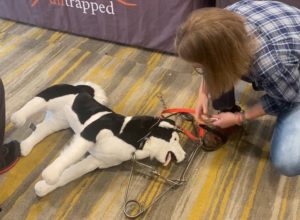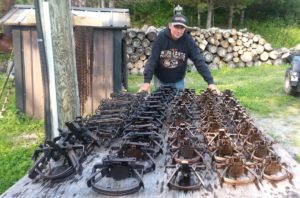Dave Pauli has a robust line in wry humor. Maybe that is just as well. In September he was in Laramie giving a trap-release workshop. A trap-release workshop, you say? Why, who needs that?
You do. Especially if you traverse Wyoming’s public lands with your dog.
~
Due to lax trapping regulations in Wyoming, dogs and other non-target species continue to be caught by leghold traps and snares. It is a particular problem in the national forest. Most dog owners are unaware of dog-trapping incidents until it happens to them or a friend or neighbor. Neither the Wyoming Game and Fish Department (WGFD) nor the United States Forest Service (USFS) directly share information about dog-trapping incidents with the public. That is left to Wyoming Untrapped, a non-profit which promotes humane approaches to furbearers and other wildlife.
The workshop was free. Wyoming Coalition for Animal Protection (WYCAP) helped offset the cost of the Laramie session, where about 35 people attended. Workshops were also held in Pinedale and Jackson.
Enter Dave Pauli, a certified wildlife naturalist and lifelong trapper. WU brought him to Wyoming to share his experience with traps, specifically what to do when a dog is caught in one. If you did not attend, one of Dave’s workshops is on YouTube.
Dave is an interesting fellow. He started trapping as a teenager, whereby hangs a beaver tale (final paragraph below). Some attendees chatted with Dave after the event. He regaled us with stories of live trapping in Morocco, Haiti, Puerto Rico, and Alaska. Much of his work is in support of trap-and-neuter programs with the Humane Society of the United States, and allied organizations.
Dave is also honest. Not all dog-trapping episodes end happily. If you hike with a good cable cutter in your pocket, chances are you will free your dog. Yet it all depends on the trapping device. If it is a leg-hold trap and you know how to open the jaws, you can retrieve a live dog. But if it is a spring-loaded snare, or a “humane” large quick-kill trap, not so much. There is a chance your dog will die before you free her. You generally have no comeback on a trapper when a dog is caught in a trap set legally on public land. Remarkably, trail setbacks are only recommended, and not required, for traps and snares in Wyoming. It is therefore legal to lay them on or near heavily hiked paths and, even more remarkably, some trappers do exactly that. If you control your impulse to panic, intervene quickly, and carry a leash, you can use the latter to compress the powerful springs of a Conibear trap. This demonstration video shows how. Unfortunately, in Dave’s experience, such traps continue to kill dogs who encounter them. Interfering with a legally set trap or snare, even to release a trapped dog, is technically a violation of WGFD trapping regulations. You may notice a pattern here. WGFD regulations are slanted in favor of the trapping fraternity. The price is paid by members of the public, and non-target animals, including wildlife. You and I need to fix that.

Still shot from Wyoming Untrapped video showing audience member using a leash to attempt to release a stuffed toy dog in a Conibear trap. “Quick-kill” body-grip traps work by a scissors-like action designed to asphyxiate wildlife by compressing the windpipe and major arteries in the neck. In some states, but not Wyoming, such traps must be completely immersed in water to minimize capture of non-target species. In Wyoming, large Conibears like this need only be partly submerged per WGFD regulations. This increases the risk to dogs and other species.
Dave’s dark humor manifested when he showed a Conibear in action. He triggered it by feeding it Trapper, a stuffed toy dog. It caught Trapper with a resounding metallic snap. One time the poor fellow’s nose flew off – Trapper’s nose, thank God, not Dave’s. Dave also had on display a heavy-duty wolf leg-hold trap. He referred to it as The Beast. As the session wound down, I noticed him shake his head while putting it away. Compassion is not much of a consideration in fur trapping and predator control.
Promotional material by WGFD and other wildlife management agencies belie this. Exaggeration and euphemism abound. This is because agencies value the income and – more importantly – the political constituency provided by trappers. Yet the revenue from trapping is paltry, especially given the low fees designed to expand trapping. An annual WGFD trapping license for resident youth is all of $6 – the price of a Big Mac combo. Agency materials speak reverently of the legacy of trapping by indigenous peoples, as though it now sustains the commercial fur trade in the lower 48. They allude to Mountain Men and tie trapping to the professional wildlife managers mantra of, “what pays, stays.” This is the assertion that wildlife must be commodified and generate income in order for populations to persist and remain healthy.1 Wildlife agencies advance tenuous arguments that trapping provides meaningful control of natural diseases like tularemia and rabies. They claim modern traps kill quickly and efficiently, and that rigorously scientific management drives the bus.2,3 They exaggerate the damage done to private property and livestock by some species, and the selectivity of lethal traps. They insist that preserving this barbaric tradition is paramount.

It is tough to be wild. A trapper displays his wares. Photo credit: https://www.trappingtoday.com/trapper-photos/ accessed 10/19/2022
A large body of data supports responsible cost-effective alternatives to lethal trapping. For beaver, whose traps can be lethal to dogs, non-lethal approaches include pond levelers and culvert exclusionary devices to reduce the risk of flooding. To its credit, WGFD uses beaver dam analogs to improve degraded riparian habitat. BDAs encourage beaver to recolonize damaged watersheds, resulting in raised water tables. Yet beaver continue to be killed in our increasingly dry state. According to WGFD, that was the fate for 4,458 in 2020. This is an underestimate as it is based on a voluntary survey completed by less than 30% of Wyoming trappers. Multiply that by 3 or more for a better estimate. Don’t forget to add in the undocumented beaver trapped or shot on private land, including those killed by the USDA’s Wildlife Services. That’s a lot of beaver to take off the landscape, particularly given their status as a keystone mammalian species which maintains and enriches wetlands.4 Sad but true: beaver are better than we are as long-term stewards of riparian habitat.5 The issue of dogs hurt and killed by legally-set snares and traps is a piece of a bigger problem. Our species cannot figure out how to live respectfully with wildlife.
National 2022 prices for pelts
| Species | Price | Species | Price | |
| Coyote | $30–$40 (“heavy Western”) | Marten | $20–$30 (“lower 48”) | |
| Muskrat | $2–$3 | Fisher* | $20–$30 | |
| Raccoon | $10–$15 (“prime, undamaged”) | Bobcat | $200-$300 (“better quality Western”) | |
| Beaver | $25 (“top quality”) | Fox | $10 | |
| River otter* | $15–$25 | Skunk | $5 | |
| Wolf | $250–$500 | Lynx | $60 | |
| Wolverine | $250–$500 | Red fox fur coat | $4,000–$6,000 | |
| Coyote fur coat | $4,000–$6,000 | Raccoon fur coat | $1,000–$3,000 |
*Note: River otter and fisher are protected in Wyoming due to their rarity, in part due to historic trapping
Sources: Trapping Today: https://www.trappingtoday.com/ accessed 10/19/2022; Madison Avenue Malls: https://www.madisonavenuemalls.com/accessed 10/19/2022
Any solution needs your advocacy. Short of a ban on lethal commercial trapping, this includes trap-free areas for heavily used public recreation lands; a ban on trigger-loaded and Senneker snares; explicit public signs warning of extant traps; setbacks of 300 feet or more from busy public trails in Wyoming; public reporting by WGFD of numbers of non-target animals trapped or killed annually; mandatory trapper education; purchase of conservation stamps by trappers; live rather than lethal traps when practical; short check periods for leghold traps (every 24 hours, instead of greater than or equal to 72 hours allowed now). The problem with snares is that they are cheap to make. It costs only 50 cents or so for a homemade wire snare for foxes, coyotes – and dogs. They can be left on Wyoming’s landscape year-round. WGFD does not require trappers to remove them at the end of each winter. It is reasonable for the public to have some legal remedy when trappers are irresponsible. Reckless trapping practices include placing traps near campgrounds, on heavily used public trails, and around designated carparks.
Dave Pauli, the fellow who led the workshop, was a boy when he started trapping wildlife. He is comfortable talking shop with trappers since he was one. He continued to trap into adulthood, killing hundreds of beavers using underwater traps. One day, after becoming director of a humane society, children brought him a live unweaned beaver kit. Dave, an experienced rehabber, fed and cared for the kit for three months. He learned from the experience, including the kit’s preference for sweet potatoes over carrots, and other personality quirks. After handing off a healthy young beaver to a rehab facility, Dave returned to lethal trapping of ‘problem’ beaver. Soon he killed one and it reminded him of the kit he bonded with. To his surprise he found himself in tears. He then and there stopped killing beaver for pelts. He still live-traps, to rescue animals and help resolve human-animal conflicts. Might be a lesson there.
Bibliography
- Macdonald, D.W., et al., 2021, Trading animal lives: Ten tricky issues on the road to protecting commodified wild animals. Bioscience. 71(8): 846–860.
- Iossa, G., et al., 2007, Mammal trapping: A review of animal welfare standards of killing and restraining traps. Animal Welfare. 16(3): 335–
- Proulx, G., and Rodtka, D., 2019, Killing traps and snares. in North America: The need for stricter checking time periods. Animals (Basel). 17;9(8): 570.
- McKinstry, M.M., et al., 2001, The importance of beaver to wetland habitats and waterfowl in Wyoming. J Am Water Resour Assoc 37: 1571–1577.
- Goldfarb, B., 2018, Eager: The surprising, secret life of beavers and why they matter. Chelsea Green Publishing, White River Junction, VT, USA.
Written by:
D. O’Toole
Wyoming Coalition for Animal Protection
November 9. 2022
***Traps photo by Cali O’Hare, Pinedale Roundup


